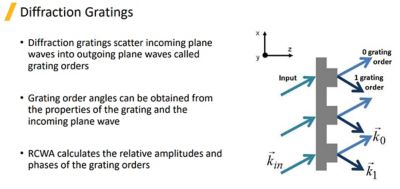-
-
Access Free Student Software
Ansys empowers the next generation of engineers
Students get free access to world-class simulation software.
-
Connect with Ansys Now!
Design your future
Connect with Ansys to explore how simulation can power your next breakthrough.
Countries & Regions
Free Trials
Products & Services
Learn
About
Back
Products & Services
Back
Learn
Ansys empowers the next generation of engineers
Students get free access to world-class simulation software.
Back
About
Design your future
Connect with Ansys to explore how simulation can power your next breakthrough.
Free Trials
ANSYS BLOG
April 11, 2023
How RCWA Solvers Support Ongoing Innovation in Optical Technologies
Innovation is essential for competitiveness, and many optical design teams are pushing the boundaries of innovation to produce ever-increasing capabilities that meet market demands across multiple industries. Let's explore how Ansys Zemax OpticStudio and Ansys Lumerical work together to enable end-to-end simulation of a complex optical design. We'll share how we've built an algorithm that allows you to more efficiently and effectively achieve decisive results.
OpticStudio and Lumerical: Macroscale Versus Nanoscale Simulation

OpticStudio enables optical design development and tolerancing at the system-level scale (macroscale) using ray tracing to simulate optical behavior, allowing optical designers to tolerance and refine their designs digitally before proceeding to prototype or product development. Lumerical analyzes and simulates optical component designs at the subwavelength scale (nanoscale) such as for metalenses and photonic integrated circuits.
Using OpticStudio and Lumerical together lets designers fully simulate their end-to-end designs at both the nanoscale and macroscale levels. Diffraction gratings are a type of nanoscale structure, often used for coupling light into and out of augmented reality (AR) waveguides.
As discussed in a previous blog, diffractive gratings are periodic optical structures that scatter incoming plane waves into outgoing plane waves called grating orders. Because diffractive gratings are at nanoscale, optical teams typically use Lumerical to simulate ray behavior when designing either standalone photonic devices or a photonic element within a larger optical system design.
Diffraction is a complex physics that introduces scattering of rays across its uneven surface. Accurately accounting for these rays requires the data of diffraction efficiency — the necessary level of precision to evaluate resulting images. Optical designers faced with modeling nanoscale period structures often use a method called rigorous coupled-wave analysis (RCWA).
Let's take a look at what RCWA is, and then introduce an Ansys Zemax feature that allows you to address this challenge.
What is Rigorous Coupled-Wave Analysis?
The RCWA method is a semi-analytical technique for solving Maxwell's equations in periodic structures. In the RCWA method, a structure is divided into uniform layers, and the modes of each layer are calculated in Fourier space. The modes are then expanded into the modes of the neighboring layers to determine how light is coupled between those layers. At this point, you can propagate a plane wave source with a specific frequency direction and polarization through the structure by expanding it into the modes in each layer, as shown in Figure 1.

Figure 1. Rigorous coupled-wave analysis (RCWA).
Some of the results that you can calculate with this method include:
- The total power transmitted and reflected.
- The electric and magnetic fields inside the structure.
- The relative phase and amplitude of the outgoing grating orders.
The RCWA method is commonly used for simulating diffraction gratings. With RCWA, the directions, amplitude, and phase of the grating orders in diffractive gratings can be obtained, given the properties of the grating and the incoming plane wave.

Figure 2. How RCWA applies to diffractive gratings.
RCWA Solver: Accurate Grating Simulation for Larger Ray-Tracing Systems
However, to conduct the detailed analysis that will get you the precision needed for diffractive optics, you need to perform Maxwell's equation. To enable this within Lumerical, we created two kinds of RCWA solver that calculate the relative amplitudes and phases of the plane waves of the grating orders: a 2D RCWA solver in Lumerical and a 1D RCWA solver in OpticStudio.
These RCWA solvers can be used in a variety of practical applications, including:
- Exit pupil expanders, a common photonic device used in AR waveguides.
- Under-screen cameras, an emerging innovation in cell phone technology.
- Micro-electromechanical systems (MEMS) applications, such as projector micro-mirror arrays.
- Flash lidar, a convenient subset of lidar that we'll discuss in a later blog post.
Historically, conducting any kind of RCWA has been a laborious, often manual process. It required using tools that are external to the simulation tools used for optical and photonic design, leading to a lot of human error. To address this challenge, the RCWA solvers transpose plane waves in RCWA into rays in OpticStudio. By treating a diffraction grating like a surface that scatters the incoming plane wave or ray into multiple outgoing rays based on those grating orders, you can use the RCWA solver to determine the angle, amplitude, and phase of the outgoing rays based on the direction of the incoming ray.
Using the RCWA solvers provides several key benefits when simulating optical designs that include diffractive gratings, such as:
- Accurate diffractive efficiencies, which are calculated using complex RCWA algorithms.
- RCWA calculations within a single interface, rather than switching to external tools.
- Faster results, accelerated by the automated calculations and integrated UI.
- Easy sharing of the resulting data sets between Lumerical and OpticStudio.
- Better uniformity in the dot matrix image projected by the diffraction.
For technical details and instructions for trying out the RCWA solver for an AR system in OpticStudio, check out this article series in the Ansys Zemax Knowledgebase.
A future blog post will discuss the "easy data sharing" benefit mentioned above and introduce a plugin we've created to enable rapid, automated transfer of relevant simulation data between Lumerical and OpticStudio.